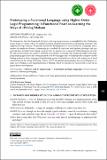Prototyping a functional language using higher-order logic programming: a functional pearl on learning the ways of λProlog/Makam
Author(s)
Stampoulis, Antonis; Chlipala, Adam
DownloadPublished version (412.3Kb)
Terms of use
Metadata
Show full item recordAbstract
<jats:p>
We demonstrate how the framework of
<jats:italic>higher-order logic programming</jats:italic>
, as exemplified in the λProlog language design, is a prime vehicle for rapid prototyping of implementations for programming languages with sophisticated type systems. We present the literate development of a type checker for a language with a number of complicated features, culminating in a standard ML-style core with algebraic datatypes and type generalization, extended with staging constructs that are generic over a separately defined language of terms. We add each new feature in sequence, with little to no changes to existing code. Scaling the higher-order logic programming approach to this setting required us to develop approaches to challenges like complex variable binding patterns in object languages and performing generic structural traversals of code, making use of novel constructions in the setting of λProlog, such as GADTs and generic programming. For our development, we make use of Makam, a new implementation of λProlog, which we introduce in tutorial style as part of our (quasi-)literate development.
</jats:p>
Date issued
2018Department
Massachusetts Institute of Technology. Computer Science and Artificial Intelligence Laboratory; Massachusetts Institute of Technology. Department of Electrical Engineering and Computer ScienceJournal
Proceedings of the ACM on Programming Languages
Publisher
Association for Computing Machinery (ACM)